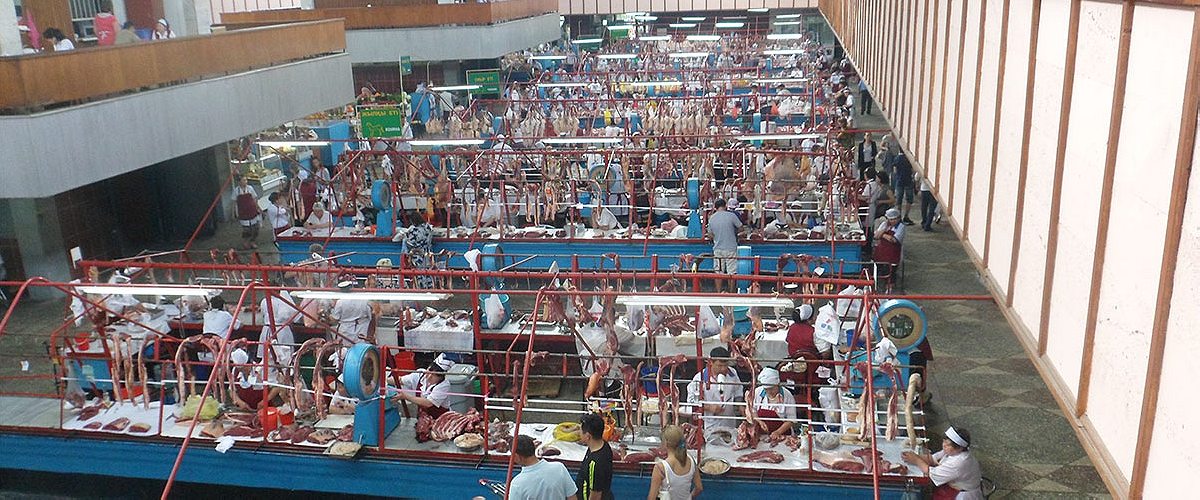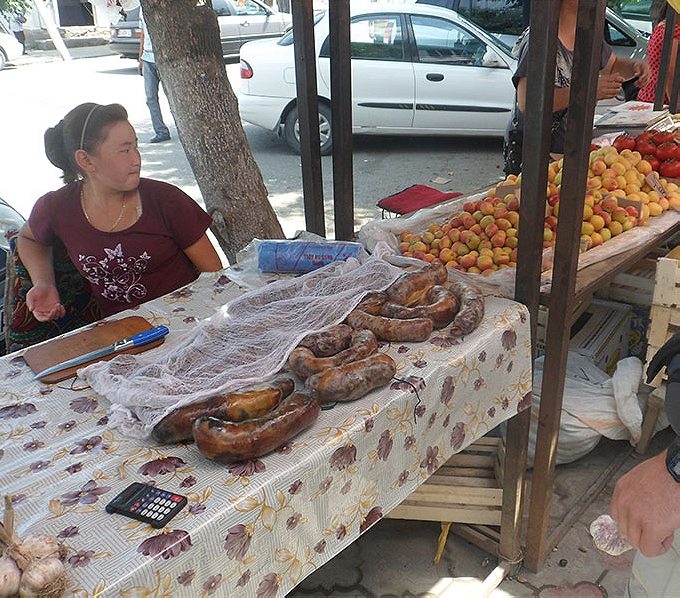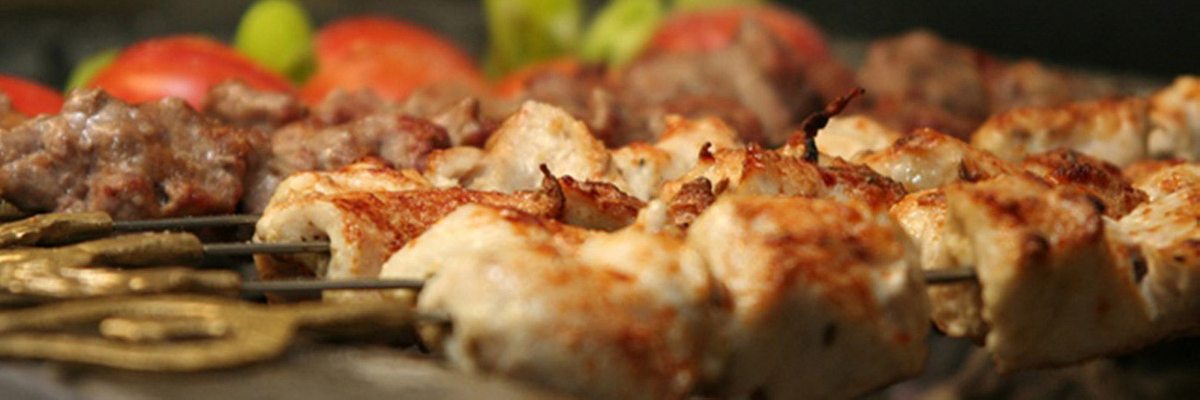Why Central Asian cuisine will win the future.
Jamil Kurbonmamadov has no respect for the fillet. “It’s an easy cut,” says the usually jovial and airy chef as he leans over a table at Samarqand, his London restaurant, suddenly stern and serious. “People here just eat easy cuts of meat [like fillet or cutlet] because it’s soft and easy to cut. You need to get the meat that the animal has worked harder. Like the hand and the neck, as close as you can get to the bone, that becomes the tastiest and most dense meat,” he explains, holding up a balled fist and tracing cut lines along the edges of his finger bones.
Most restaurants, according to Kurbonmamadov, just work with what they have. But for him and every other chef of the Central Asian diaspora I’ve met, just working with a fillet is unacceptable. As Muzaffar Sadykov, the chef at Pasha Kyrgyz Kazakh House in Camberwell, explains, every dish in Central Asian cooking requires a unique cut of meat to anticipate the effect that boiling, searing, chopping, or any other combination of processes will have on the length of the fibers, the degradation of the tendons, or any other element of the end-texture of the meat. Muzaffar’s disdain for mechanized butchery, which focuses on the presentation of the raw cut, leads him to make his own bespoke cuts of meat for many of his dishes. Kurbonmamadov takes it a step further, bringing in a Bukharan butcher, Maksud, apprenticed to his father in Uzbekistan from the age of ten, whose cuts sail right along the bone leaving no meat behind.
It’s not just the chefs coming from Central Asia who go to such lengths. In fact, Kurbonmamadov was not a chef at all—back home in Ishkashim in the Pamir Mountains of Tajikistan, he was a soil scientist and the regional director for the Aga Khan Foundation, but after starting as dishwasher in the University of Oxford’s kitchens, he rose through the ranks and gave up his other part-time jobs in 2009 to become a full-time chef, taking over his own kitchen in 2011. The hours are miserable—60 to 70 hours a week—but the ability to recreate home and a communal space for the Central Asian community, he says, drew him in. He’s not alone in feeling that magnetism—Central Asian culinary traditions draw many members of the diaspora to what can seem like extreme ends.
This obsession with the right meat follows the diaspora wherever it goes. In California, voters made the slaughter of horses, the exportation of horses for slaughter, and sale of horsemeat for human consumption illegal in 1998, shutting down one of the last bastions for horse-based cuisine in America. The ban hit the Kazakh and Kyrgyz diasporas in San Francisco hard, says Alma Kunanbaeva, a native Kazakh and professor of Central Asian nomadic cultures at Stanford University; horsemeat is the pillar of their cuisine, from beshbarmak (boiled horse dumplings) to shuzhuk (fatty horse-intestine sausages) to zhal (smoked horse neck fat). But, Kunanbaeva says, there are rumors of members of the San Francisco community finding a way around the ban—sneaking out of the city in the middle of the night to poach wild horses in Nevada and smuggling the carcasses across the state line by dawn.
The horse poaching might be folklore, Kunanbaeva stresses, but at the very least it’s common to see slabs of lamb (the next-best thing to horse) hanging from San Francisco balconies, being salted, dried, or smoked by determined Central Asian households. When Zhanara Nauruzbayeva, now a post-doctoral fellow at Columbia University, first came to California she found a halal butcher who would agree to sell her whole lamb legs (which she carried home bloody and dangling into view of the streets from her open backpack) so that she could butcher them herself at home and properly divide out the symbolic bones.

Central Asians are not alone in the measures they take to recreate their national cuisines wherever they land. Thanks to the wonders of cheap, fast modern refrigerated air shipping, New York runneth over with Peruvian restaurants using fresh choclo corn or Indonesian restaurants making their gudeg with jackfruits fresh from the chefs’ home regions. But Central Asian diaspora chefs are notable for their devotion to minutia in their cooking at any cost. Chef Sadykov talks about customers who, upset with the quality of rice in the United Kingdom, fly in sacks of the larger, harder grains from their home region of Uzgen, Uzbekistan and then instruct him to only use Uzgen rice (otherwise completely absent in London) when he cooks for them. This seems to him to be the norm rather than the exception.

Part of that obsession tracks with the running quest of the Central Asian republics to reassert their ethnic identities after around 70 years of Soviet rule. It’s odd to say, given that everyone knows of Stalin’s pogroms, but it’s true that we often underestimate just how deeply Stalin’s writs transformed the culture—even in regards to food.
An anthropologist named Nancy Rosenberger from Oregon State University wrote about this in a journal article called “Patriotic Appetites and Gnawing Hungers: Food and the Paradox of Nation-Building in Uzbekistan,” Her central thesis is that food is a daily and unconscious reminder of who we are and what we can and can’t grow and sell. Over time, it either forms an enduring and sensually meaningful social bond, or it breaks us apart as a sign of class, faith, and ethnicity. But the USSR steamrolled over those cultural bonds, radically transforming what its Central Asian subjects could own and grow and eat: by the end of the 1950s they’d reduced Uzbekistan to a cotton monoculture economy, and were on their way to creating an ungodly dustbowl in Kazakhstan after forcing 40 million hectares of land into monoculture grain farming. Across the steppe, it’s not uncommon to hear stories of nomadic populations compelled to turn over their herds to collectivized farms and resisting by slaughtering millions of head of livestock en masse. One of Nauruzbayeva’s friends even has a copy of a Soviet era, state-printed Central Asian cookbook, with its front page ripped off as it once carried a quote from Stalin.
Throughout the Soviet period, Nauruzbayeva recalls, the preservation and daily consumption of traditional foods was one way of perpetuating a unique ethnic and national identity. They assiduously kept the rules for cutting meat and dividing bones and meat amongst guests to reaffirm social status and bestow honor: the head of the lamb going to the eldest, the ears and tongue to the children, the shanks to the mother-in-law, and the breast to the son-in-law. These forms of quiet self-assertion built the foundation for the obsessive detail in modern Central Asian butchery. After independence, Kunanbaeva adds, food just became an even more visible and vital expression of ethnic pride than ever before.
But there’s a non-political side to the obsession—the part that accounts for the manic attempt to control every stage of the production of meat and every course of the knife along the bone rather than just serving noodles in spiced tomato broth for dinner and calling it lagman. Central Asian food is inherently ingredient-driven. It doesn’t rely on the right level of spice or juxtaposition of flavor for its proper taste. Without the fiery peppers or brighter flavors of south or east Asian cuisine, in Central Asia, the core ingredients have to be able to stand on their own.
Short of horses, they located a sheep farm in the DC area and slaughtered it on the spot.
Kunanbaeva once wrote about a delegation of 18 Kazakhs who came to Washington, D.C., in 2002 and, disappointed with the food provided at the events they attended, decided to make some beshbarmak of their own. Short of horses, they located a sheep farm in the area, drove down, and slaughtered it on the spot. But even with a fresh sheep, killed and butchered precisely as they liked it, the Kazakhs were disappointed with the experience—they said the grass was too watery and the pen too small, manifesting itself in a weak and diluted flavor in the meat.

Some Central Asians claim to be able to taste the sex, age, grazing conditions, and cooking methods in any meat. They claim to recognize the type of flour, temperature of the water used to mix it, amount of salt added, and time spent kneading the pastries used in beshbarmak. Nauruzbayeva says that the quality of meats from different regions is a major subject of discussion in Kazakhstan, much like wine tasting in the rest of the world, with people praising the flesh from Aktobe above all others. As with wine tasting, some (Nauruzbayeva included) own up to not tasting a difference. But Samarqand’s chef Kurbonmamadov is unyielding: Central Asians, he insists, have the ability to taste the history of a cut of meat. It’s a matter of culinary science, he says, because of the definitive change in muscle and sinew toughness the longer one hangs a carcass. But there’s also personal experience, the stench and flavor of a yak’s milk when it eats the sprouts of the spring onions in the Wakhan valley, the minerality of water from a certain district, and all the other flavors from a far-away home.
Kurbonmamadov, like all Central Asian chefs in the diaspora, tries to control the supply chain of his ingredients as much as possible. He researches the butchers and the pastures their meat comes from, makes his own broth, and trains his own chefs from novice status upwards. He has one Macedonian youth devoted specifically to making lagman noodles from scratch, a four-hour labor-intensive process that would be intolerable to anyone who didn’t have a nearly demented love of the details of each step. He compensates as best he can with spices, kicking up the familiar flavors according to the regions customers come from (he makes five types of manti dumplings, those for the Kazakhs with more Chinese chives and those for the Tartars with more hearty meat and potatoes). Even Kunanbaeva, in her own kitchen, tries to make sure she has a proper kazan pot to cook rice and has recorded numerous tips and tricks for making ones dishes as close to Kazakh standards as possible (she finds flour-based foods easier to control than meat, which is harder to source authentically).
Kurbonmamadov found a sample of horse intestine, but it was a disappointment.
In bigger diasporas, like the Uzbeks of New York, there’s a better chance of finding some niche ingredients like cotton oil for frying foods. But law is law, and it is sometimes an obstacle. Horse is the most obvious example. And even when Kurbonmamadov did manage to procure a controlled sample of horse intestine in London, it turned out a disappointment, with not nearly enough fat in it to be worth a damn as shuzhuk.
In the US and UK, there are various prohibitions on traditional fermenting processes (like using sheep’s stomach, mineral stones, and natural yeast) and on un-homogenized milks and creams, mean that most almost all traditional forms of dairy cannot be recreated off the steppe. Nor does the modern state smile upon social traditions associated with Central Asian butchery, like Pamiris hanging slaughtered livestock outdoors in the winter for two to three months, or Kazakh steppe nomads ritualistically flagellating sick men with the lungs of a fresh-slaughtered sheep, swung about using the trachea as a handle like a flail. Some things cannot even be created as a shadowy replica of the original.
It doesn’t help matters that the Central Asian culinary scene is often regionally fractured, especially in London. Kurbonmamadov finds it particularly hard to please Kazakh and Russian customers, and even though Samarqand’s owners are Uzbeks, their fellow Londoner Uzbeks flock to their own restaurants on Canary Road and in Kilburn. There are few Tajiks in the UK—perhaps 2,000 to 3,000 (and only about 110 from the Pamir region Kurbonmamadov hails from). With such small natural constituencies, there’s no way to run a business without bowing somewhat to local tastes. Kurbonmamadov personally believes you’ve got to see the oil dripping off a manti to know it’s right, but for the sake of English customers he cuts back on oil, fat, and cumin seeds. Neither he nor I are quite sure why English customers complain so often about cumin seeds. Muzaffar’s menus do more than just nod to British food; he includes some pub items in his lineup and focuses on gussying up the presentation of his food, serving coiffured lagman rather than just slapping some noodles into a splattering red sauce.
Central Asians will not accept radically different foods wholly imported from foreign cultures.
These hybrids aren’t yet creating new types of American or British cuisine (like Brindian curries or Italian-American standards), but they are starting revolutions back home. After being forced to think deeply about the science of cooking, Kurbonmamadov now travels back to the Pamirs regularly, finding ways to alter regional cuisines and augment local practices to bring out a fuller flavor. Sadykov says he has big plans for revolutionizing the culinary scene in Osh, Kyrgyzstan, but clams up about the details, just saying he’s learned a few things about how to tweak plov and lagman. But both men accept the conventional wisdom that Central Asians, for love and devotion to their traditional foods and through sheer inertia, will not accept radically different foods wholly imported from foreign cultures—the best anyone can get away with, says Sadykov, is the introduction of chicken through Turkish-Uzbek fusion dishes, dreamed up by Uzbek, not Turkish, chefs.
Nauruzbayeva’s example, though, suggests that the experimentation and hard-knock food science education of the diaspora can lead to more drastic fusions and revolutions in Central Asian cuisine. She and her husband traveled to Osh in 2009, in part to do anthropological research on food culture, and decided to create a pop-up fusion café in the market (a journey recorded for a while in their blog, The Borrowed Kazan, which they renamed The Broken Kazan after ethnic riots in 2010 left scores dead and their beloved market in ashes). Their menus included lagman Bolognese, but also hamburgers and pizzas made with buns modified from traditional bread baked by the local lepeshki bread maker. The latter dishes were actually made at the insistence of locals and went over like gangbusters. People like Kunanbaeva are still convinced that Western-style low-fat, low-cholesterol, “tasteless” foods will never catch on in Central Asia, but the opportunities for fusion and innovation are limitless.
As for the diaspora who don’t return to revolutionize the steppe, they’re looking for an explosion of Central Asian food in the West. People like Kurbonmamadov, whose insistence on control leads him to apprentice and train his own chefs, have become small factories for full-fledged masters of diaspora Central Asian cooking. Emboldened by their unique skill set, they leave almost as fast as Kurbonmamadov can train them, and many are off now scheming to open their own restaurants. Often from different cultures themselves, but trained with unusual systematic awareness of the intersection of cut and cooking, these eager young Turks (or Uzbeks, as it were), entering a world increasingly obsessed with the provenance of ingredients, could be the future. They could be the ones to form unknown and exciting combinations that bring Central Asian traditions into the global mainstream. We would all be better eaters if it were so.